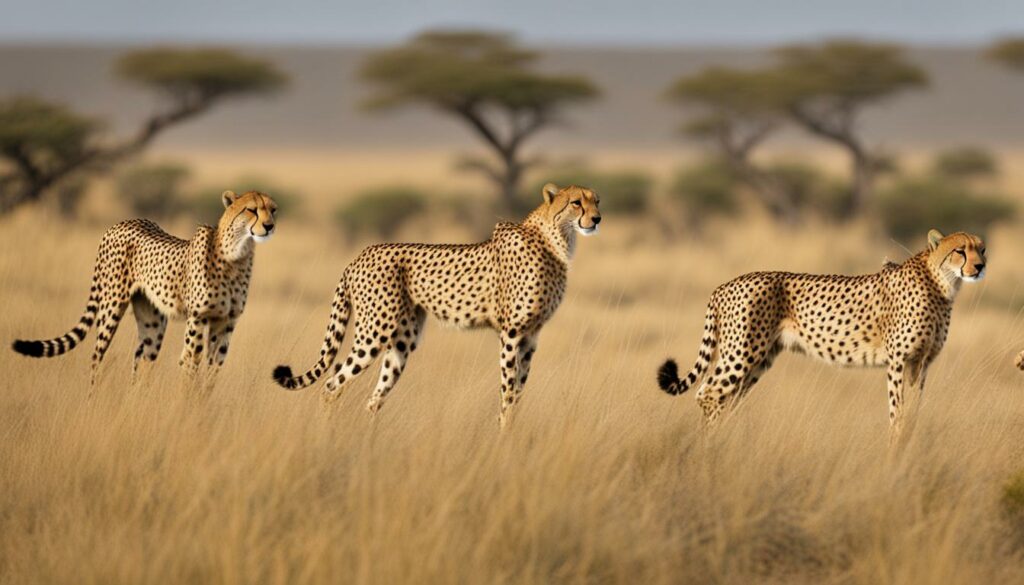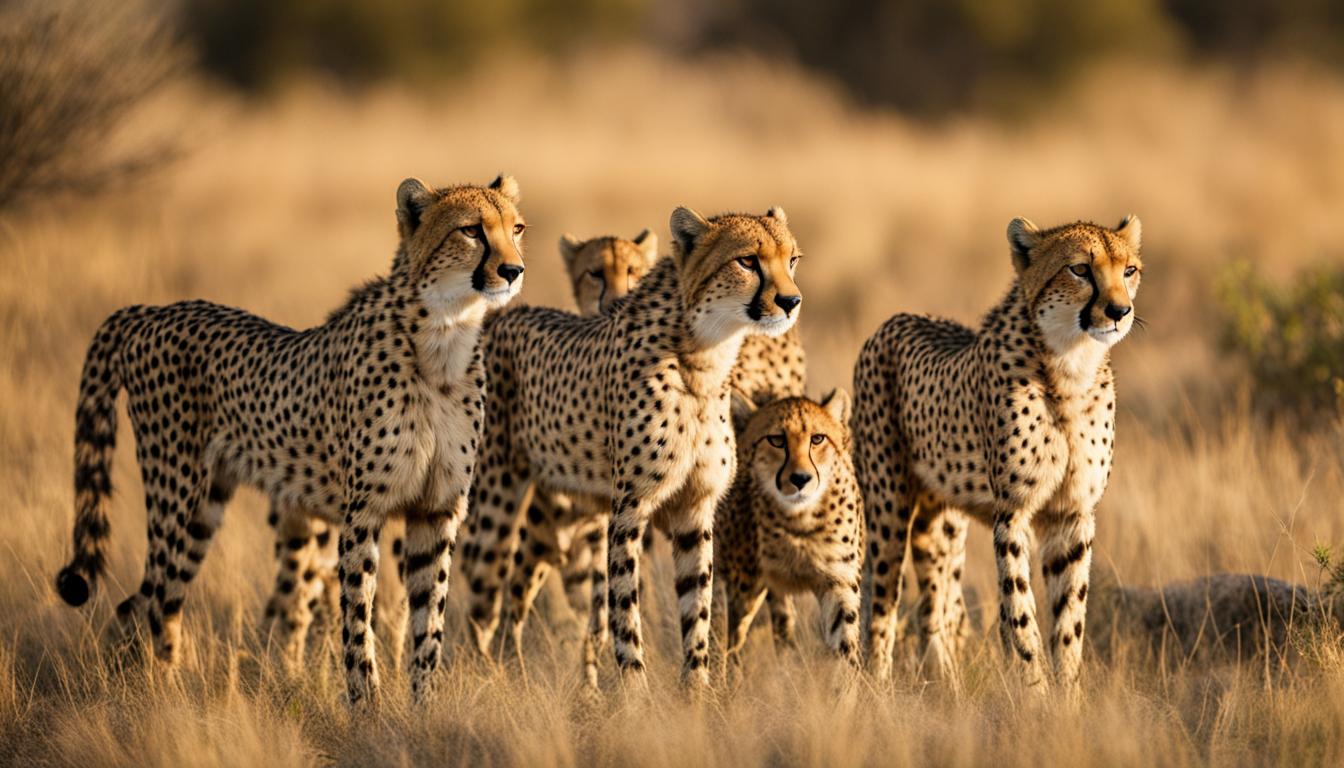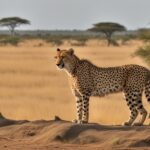Cheetahs live in small social groups comprised of related females and their offspring. They form close bonds and engage in cooperative behaviors such as grooming and caring for each other’s young. Living in groups provides advantages such as protection from predators and access to resources.
The size and composition of cheetah groups are influenced by relatedness and the availability of resources. Dominance hierarchies exist within cheetah groups, with a dominant female leading the group and making decisions. Males also form coalitions to protect their territories and increase their chances of finding mates.
Explore how cheetahs establish social hierarchies and the benefits of group living in the sections below.
The Advantages of Cheetah Group Living
Living in a group offers several advantages for cheetahs. It provides protection from predators, as multiple cheetahs can work together to distract and drive off threats. Group living also allows for resource sharing, including food and water, which can be scarce in their natural environment. The close bonds between female cheetahs enable them to share caretaking duties for cubs, providing support for single mothers. Having multiple adults in a group helps cubs learn important survival skills.
One of the main advantages of cheetah group living is the enhanced protection against predators. Cheetahs are known for their incredible speed, but even they can be at risk from larger predators such as lions and hyenas. By living in a group, cheetahs can collaborate to defend themselves and their young. They use their sharp claws and teeth, as well as their strong social bonds, to deter potential threats. This cooperative behavior increases their chances of survival, particularly when it comes to protecting vulnerable cubs.
Another advantage of group living is the sharing of resources. Cheetahs primarily prey on small to medium-sized ungulates, such as antelopes. However, these prey animals can be scarce in certain habitats, leading to competition for food. By living in a group, cheetahs can coordinate their hunting efforts and increase their chances of a successful kill. Additionally, group members can share their kills, ensuring that each member has access to food. This resource sharing is especially important for young cheetahs who are still learning how to hunt effectively.
| Advantages of Cheetah Group Living | Description |
|---|---|
| Protection from predators | Living in a group allows cheetahs to work together to defend against threats from larger predators. |
| Resource sharing | Cheetahs can collaborate to hunt and share food, ensuring access to vital resources. |
| Cub care and learning | The close bonds between female cheetahs enable them to support each other in raising and teaching their young. |
The advantages of cheetah group living extend beyond protection and resource sharing. The close bonds between female cheetahs play a crucial role in cub care and learning. Young cheetahs require guidance and instruction to develop their hunting skills and survive in the challenging African savannah. Female cheetahs within a group take turns caring for the cubs, allowing each mother to rest and hunt. This cooperative parenting not only alleviates the burden on individual mothers but also exposes the cubs to different teaching techniques and experiences, enhancing their overall development.
In conclusion, cheetahs benefit greatly from living in groups. The advantages of protection, resource sharing, and cooperative cub care contribute to their survival and success in the wild. However, it is important to recognize the unique challenges and dynamics within cheetah groups, which will be explored further in the following sections.
Factors Influencing Cheetah Group Dynamics
Cheetah group dynamics are influenced by various factors that shape the composition and structure of these social groups. Understanding these factors is essential for comprehending the complexities of cheetah social behavior and population dynamics.
Relatedness and Group Formation
The formation of cheetah groups is largely influenced by relatedness among individuals. Female cheetahs often travel and form groups with their siblings, mothers, and aunts, creating a network of closely related individuals. This kinship-based grouping enhances cooperation and support within the group, ensuring the survival and well-being of its members.
Males, on the other hand, may temporarily join a group to provide additional protection against predators. These temporary alliances are formed to enhance the group’s defensive capabilities and increase the chances of successful resource acquisition.
Resource Availability
The availability of resources, such as food, water, and the presence of other predator species, plays a significant role in shaping cheetah group dynamics. When resources are plentiful, groups may come together, forming larger and more cohesive units. This allows for increased cooperation and coordination in hunting and defense against predators.
However, when resources are scarce, groups may split up, with individuals dispersing in search of alternative sources. This can result in the formation of smaller, fragmented groups as cheetahs compete for limited resources.
Impacts of Cheetah Group Dynamics
Cheetah group dynamics have significant implications for the overall population dynamics of these magnificent big cats. The size and composition of cheetah groups influence mating opportunities, competition for resources, and the survival prospects of individuals.
Understanding the factors that influence cheetah group dynamics is crucial for conservation efforts aimed at ensuring the long-term viability of cheetah populations. By preserving and protecting their natural habitats, managing resources sustainably, and minimizing human interference, we can help maintain the intricate social structure and balance within cheetah groups.
The Complexity of Cheetah Interactions
Cheetah social interactions are complex and involve strong bonds between female cheetahs, established through grooming and other social behaviors. Dominance hierarchies are established within groups and maintained through aggressive behaviors such as chasing and vocalizing. These hierarchies can change over time based on factors such as resource availability and individual characteristics. Grooming has been shown to reduce stress and improve trust between cheetahs, contributing to the overall social structure of the group.
In cheetah groups, social interactions play a crucial role in establishing and maintaining the group’s cohesion. Through grooming, cheetahs strengthen social bonds and build trust within the group. Grooming not only helps to keep their fur clean but also serves as a form of stress relief and communication. It is a way for cheetahs to express their affiliative behavior and reinforce their social connections.
“Grooming has been observed to have a calming effect on cheetahs, helping to reduce stress and promote social harmony within the group.” – Researcher at the Cheetah Conservation Initiative
In addition to grooming, aggressive behaviors play a crucial role in establishing dominance hierarchies within cheetah groups. Dominant individuals often engage in chasing and vocalizing to assert their authority and maintain their status. Dominance hierarchies can change over time, especially during periods of resource scarcity or the introduction of new individuals to the group. These changes in social dynamics contribute to the overall complexity of cheetah interactions.
| Key Factors in Cheetah Interactions | Effect |
|---|---|
| Grooming | Promotes social bonding and reduces stress |
| Aggressive behaviors | Establish and maintain dominance hierarchies |
| Resource availability | Influences changes in social dynamics |
| Individual characteristics | Affects dominance and social interactions |
The complexity of cheetah interactions highlights the intricate social structure within these groups. Grooming and aggressive behaviors play essential roles in establishing and maintaining social hierarchies, ensuring the cohesion and survival of the group. Understanding the dynamics of cheetah interactions is crucial for conservation efforts and the preservation of their unique social behavior.
The Role of Dominance in Cheetah Groups
In cheetah groups, dominance plays a significant role in establishing social hierarchies and organizing group dynamics. Understanding the role of dominance is crucial for comprehending the complex social structure of these fascinating animals.
Within female cheetah groups, a linear hierarchy is usually established, with one dominant female leading the group. She assumes the responsibility of making decisions about movement and resource pursuit, and she also has priority access to food. The dominant female’s authority and social ranking are upheld through assertive behaviors and vocalizations, reinforcing her position within the group.
“Dominance in cheetah groups is often displayed through aggressive behaviors such as chasing and vocalizing. These behaviors help maintain the stability of the group and regulate resource access.”
Male cheetahs also establish dominance hierarchies within a group, although these hierarchies are more complex due to the temporary nature of male membership. Males form coalitions to protect their territories and increase their chances of mating, resulting in a multi-layered social structure within the group. Dominance among males impacts resource access and influences overall group cohesion.
The Benefits of Dominance
Alpha cheetahs, both female and male, play a critical role in maintaining group cohesiveness and maximizing survival opportunities. Dominant individuals have better access to resources such as food, water, and mates, which ensures their own reproductive success and ultimately contributes to the success of the entire group. By establishing dominance hierarchies, cheetahs reduce conflict and maintain social order, enabling efficient decision-making and resource allocation.
| Dominant Female | Advantages |
|---|---|
| Priority access to food | Ensures optimal nutrition and survival |
| Leadership role in group decisions | Guides the group towards favorable resources and habitats |
| Higher breeding success | Increased chances of passing on genes to future generations |
By delving deeper into the role of dominance in cheetah groups, researchers can gain valuable insights into their social structure and behavior. This knowledge is crucial for both conservation efforts and enhancing our understanding of this iconic species.

| Mating Habits | Territory Defense |
|---|---|
|
|
Conclusion
Cheetahs exhibit fascinating social behavior, with complex group dynamics and dominance hierarchies. Living in groups provides numerous advantages, including protection from predators and access to resources. However, human interference has had a significant impact on cheetah group dynamics, leading to reduced populations and increased competition for resources.
Conservation efforts are essential to protect cheetah habitats and preserve their unique social structure. By understanding cheetah social behavior, we can develop effective strategies to ensure their survival. This includes protecting their natural habitats, addressing poaching and illegal wildlife trade, and promoting sustainable development practices in areas where cheetahs reside.
Research plays a crucial role in conservation efforts, helping us to better understand the impacts of human interference on cheetah behavior and identify the most effective conservation strategies. By supporting conservation organizations, raising awareness, and advocating for stronger laws and regulations, we can contribute to the preservation of cheetahs and their remarkable social behavior.
Are the mechanisms for establishing social hierarchies in cheetah groups similar to those in chimpanzee groups?
Yes, the mechanisms for establishing social hierarchies in cheetah groups are similar to those in chimpanzee groups. Both species rely on dominant individuals to assert their authority and maintain order within the group. The social hierarchies in chimpanzee groups are shaped by similar dynamics of dominance, submission, and competition for resources.
Do cheetahs and leopards establish social hierarchies in a similar way?
Cheetahs, known for their speed, favor a solitary existence with minimal social structure, unlike leopards’ diet and hunting habits which can influence hierarchical behaviors. Leopards, versatile in their diet and nocturnal hunts, may display more complex social dynamics due to resource competition, something less observed in cheetahs.
FAQ
How are social hierarchies established in cheetah groups?
Social hierarchies in cheetah groups are established through dominance behaviors such as chasing and vocalizing. The dominant female leads the group and makes decisions, while dominant males form coalitions to protect territories and increase their chances of mating.
What are the advantages of cheetah group living?
Cheetahs living in groups have several advantages, including protection from predators through cooperative defense, resource sharing such as food and water, and shared caretaking duties for cubs. Group living also allows for learning important survival skills.
What factors influence cheetah group dynamics?
Cheetah group dynamics are influenced by relatedness, availability of resources, and the presence of other predator species. Groups are typically formed based on relatedness, and when resources are scarce, groups may split up or come together depending on the situation.
What are the complexities of cheetah interactions?
Cheetah interactions involve strong bonds between female cheetahs, established through grooming and other social behaviors. Dominance hierarchies exist within groups and can change over time based on resource availability and individual characteristics. Grooming reduces stress and improves trust between cheetahs.
What is the role of dominance in cheetah groups?
Dominance plays a significant role in cheetah group dynamics. The dominant female leads the group and makes decisions, while dominant males establish territories and form coalitions to protect them. Dominance impacts resource access and overall group cohesion.
What are the mating habits and territories of cheetahs?
Dominant males establish territories and defend them from rival males using vocalizations and scent markings. These territories are important for breeding, as dominant males have better access to females during mating season. Female cheetahs mate with multiple males to increase genetic diversity.
What can be concluded about cheetah social behavior and conservation efforts?
Cheetah social behavior is complex and fascinating, with unique group dynamics and dominance hierarchies. Human interference has impacted cheetah populations and their competition for resources. Conservation efforts are crucial to protect cheetah habitats and preserve their social structure.










